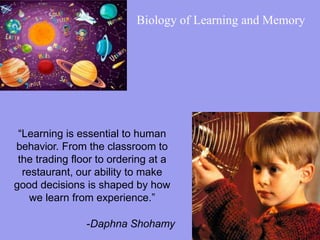
Biology of Learning and Memory.pptx
- 1. “Learning is essential to human behavior. From the classroom to the trading floor to ordering at a restaurant, our ability to make good decisions is shaped by how we learn from experience.” -Daphna Shohamy Biology of Learning and Memory
- 2. 13 Learning and Memory What is the nature of learning? Learning is the process by which experiences change our nervous system, and hence our behavior. We call those changes memories.
- 3. 13 Overview Four basic forms of learning: • Perceptual learning • S-R (associative) learning • Motor learning • Relational learning
- 5. • Neurobiologists generally believed that memories were generally not the result of new neuron production • 1894: Santiago Ramon y Cajal thought memories were formed by strengthening neuron connections • 1949: Hebbian theory 13 Early Learning Theory
- 6. 13 Early Learning Theory TAKE NOTE!
- 7. • Changes in the structure or biochemistry of synapses that alter their effects on postsynaptic neurons • Long-term Potentiation: long term increase in the excitability of a neuron to a particular synaptic input caused by repeated high-frequency activity of that input. • Long-term Depression: produces a long- lasting decrease in synaptic strength. 13 Synaptic Plasticity
- 8. • Associative long-term potentiation: weak synapses are strengthened by the action of strong synapses • NMDA receptor: A specialized ionotropic glutamate receptor that controls a calcium channel that is normally blocked by Mg2+ ions; involved in long-term potentiation. • AMPA receptor: An ionotropic glutamate receptor that controls a sodium channel; when open, it produces EPSPs. 13 Synaptic Plasticity
- 9. 13 Perceptual Learning • Involves learning to recognize things, not what to do when they are present • Can involve learning to recognize entirely new stimuli, or it can involve learning to recognize changes or variations in familiar stimuli • We learn that particular stimuli are found in particular locations or contexts or in the presence of other stimuli. We can even learn and remember particular episodes: sequences of events taking place at a particular time and place.
- 10. • Thalamus LGN -> primary visual cortex -> extrastriate cortex • Objects are recognized visually by circuits of neurons in the visual association cortex. • Damage to the inferior temporal cortex leaves vision unaffected but causes inability to discriminate visual stimuli • Ventral = what, Dorsal = where 13 Perceptual Learning
- 11. • Involves changes in synaptic connections in the visual association cortex , creating new neural circuits • When exposed to the same stimulus, the same circuits become active 13 Perceptual Learning
- 14. • MT/MST: region of the visual association cortex that perceives movement • Memory contains information about previously seen movements • Brain saves sensory information for future reference 13 Perceptual Learning
- 15. • The memory for a stimulus or an event that lasts for a short while • Involves activating established neural circuits even after stimulus is gone • Delayed matching-to-sample task: A task that requires the subject to indicate which of several stimuli has just been perceived. 13 Short-term Memory
- 17. • Involves several brain regions • Prefrontal cortex manipulates and organizes information to be remembered • PFC devises strategies for retrieval and monitors the outcome of those processes • Successful remembering requires: filtering out irrelevant info and maintaining relevant info 13 Short-term Memory
- 18. S-R Learning
- 19. 13 S-R Learning Hebb’s rule: Neurons that fire together, wire together. S-R Learning is to learn to perform a particular behavior when a particular stimulus is present
- 20. Ivan Pavlov While studying salivation in dogs, Pavlov “stumbled” upon the principles of classical conditioning. 13 S-R Learning
- 21. In classical (Pavlovian) conditioning, a neutral stimulus is paired with another stimulus that elicits a response. Eventually, the neutral stimulus by itself will elicit the response. 13 S-R Learning
- 22. 13 S-R Learning
- 23. 13 S-R Learning
- 24. 13 S-R Learning
- 25. B.F. Skinner 13 S-R Learning He was a firm believer that any human action was the result of the consequences of that same action.
- 26. In instrumental (operant) conditioning, an association is made between: • Behavior (the instrumental response) • The consequences of the behavior (the reward). 13 S-R Learning
- 27. Positive vs. Negative Reinforces 13 S-R Learning
- 28. The Reinforcement System 13 S-R Learning Detect the presence of a reinforcement stimulus. Strengthen the neural connections between the discriminative stimulus and the instrumental response.
- 29. 13 S-R Learning
- 32. • Iconic memories are the briefest memories and store sensory impressions that only last a few seconds. • Short-term memories (STMs) usually last only for up to 30 seconds or throughout rehearsal. Short-term memory is also known as working memory. 13 Memory I work out!
- 33. • An intermediate-term memory (ITM) outlasts a STM, but is not permanent. • Long-term memories (LTMs) last for days to years. 13 Memory
- 34. 13 Relational Learning Henry Molaison suffered from severe epilepsy. Because of seizures, a decision was made to remove the amygdala, the hippocampus, and some cortex. Patient H.M.
- 35. • Retrograde amnesia is the loss of memories formed before onset of amnesia and is not uncommon after brain trauma. • Anterograde amnesia is the inability to form memories after onset of amnesia. 13 Relational Learning H.M. had normal short-term memory but had severe anterograde amnesia.
- 37. Dissociation of explicit (declarative) memory, which was impaired vs. Implicit (nondeclarative) memory, which was fine 13 Relational Learning
- 38. • Declarative memory deals with what—facts and information acquired through learning that can be stated or described. (Things we are aware that are learned.) • Nondeclarative (procedural) memory deals with how—shown by performance rather than conscious recollection. 13 Memory Two kinds of long-term memory:
- 39. 13 Memory
- 40. 13 Memory
- 41. • Long-term memory has a large capacity. • Information can also be forgotten or recalled inaccurately. 13 Memory
- 42. THE END